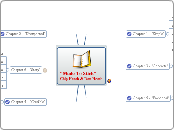realizată de Mark Hollander 18 ani în urmă
618
"Made To Stick" Chip Heath & Dan Heath
An outline of Chip Heath and Dan Heath's best selling book. You may read, but not modify this map. For questions contact us at www.group8020.com

realizată de Mark Hollander 18 ani în urmă
618

Mai multe ca aceasta
challenge people's "intuition"
Which of the following events kill more people?
in US, 50% more deaths from suicide than homicide
9x more deaths from tuberculosis than floods
80x more death from asthma than tornadoes
pp159-160
Ronald Reagan "Are you better off now than you were four years ago?"
which of the following animals is more likely to kill you?
Shark
Deer
the deer is 300x more likely to kill you via a collision with your car
figured if they deployed wireless for the employees would cost $500 per year per employee to maintain
investment not a benefit (like medical or dental)
you have to get $501 worth of additional value from each employee each year to pay for it
"if you believe you can increase an employees productivity by one to two minutes a day you've paid back the cost of wireless"
page 144-145
4 out 11 players on the field would know which goal is their own
only 2 out of11 would care
appeals to our schema of soccer rather than numbers or statistics
The Darth Vader toothbrush
nurse spilling mercurochrome on her white uniform when applying the bandage
"what would someone like me do?
don't mess with Texas example
"What's in it for my group?"
don't forget to appeal to "what would the group do?"
fireman example
fireman offered a film on fire safety. answer was yes. when coupled with an offer for a free popcorn popper or other gift, they were insulted.
"Fireman don't need to be bribed!"
Save the Children Example
You can sponsor Rokia, a little girl in Mali, for $30/month." -- ok, uses the Mother Theresa principal.
Better
"imagine yourself as the sponsor of Rokia, a little girl in Mali. You've a got a picture of her on your desk at work, next to your kids' pictures. During the past year, you've traded letters with her three times and you know from the letters that she loves to read and frequently gets annoyed by her little brother. She is excite that next year she'll get to play on the soccer team'
people don't buy 1/4" drill bits, they buy 1/4" holes so they can hang their children's pictures
http://www.amazon.com/Sources-Power-People-
Make-Decisions/dp/0262611465/
originally 11 different pasta shapes and 30 different flavors
but learned that moms and their kids valued predictability (didn't want kids rejecting something new)
moms struggled to find the flavor/version that their kids would eat on the grocery store shelf -- too many choices
in the end simplified product line, huge cost savings, yet moms were happier.
sales grew 11% in 2005
pp 126-128
Melissa Studzinski, product manager
General Mills
In the 1960s when Boeing prepared to launch the design of 727 passenger plane it's manages set a global that was deliberately concrete:
the 727 must seat 131 passengers
fly nonstop from Miami to New York City and land on Runway 4-22 at La Guardia (this runway was chosen for its length, less than a mile which was too short for any of the existing passenger jets)
With this concrete goal, Boeing effectively coordinate the actions of thousand of experts in various aspects of engineering or manufacturing.
Imagine if they had set the goal to be "the best passenger plane in the world"
we forget that other people don't know what we know
when you break the gap, you draw them in
ask them to commit to a stance on a core message
well all have it
Robert McKee's book
provide context
if the gap is an "abyss" then fill it in just enough
point out the gap
4. Then help them repair and refine their original schema
3. Communicate the core message in a way that breaks the schema along a critical, counter-intuitive dimension
2. Identity what is counter-intuitive (unexpected implications)
1. Identify core message you want to communicate
invite the audience to participate in solving the mystery
you must create a need and desire for closure
describe situation which makes no sense
Interest
Surprise
to work must be satisfying
must target an aspect of the core message
avoid gimmicks
must be post-predictable
makes us want to find the answer
don't merely summarize
then and only then do you tell people what you want them to know
makes you want an answer
makes you care
create a gap
"The Gap Theory"
you can open a gap by...
mystery
"how will the story turn out?"
"was I right?"
we must first open a gap before closing it with an answer
psychologist Donald Redelman
"The single most important thing we must do is _____"
"If we accomplish nothing else tomorrow we must.____"
Forced prioritization is painful